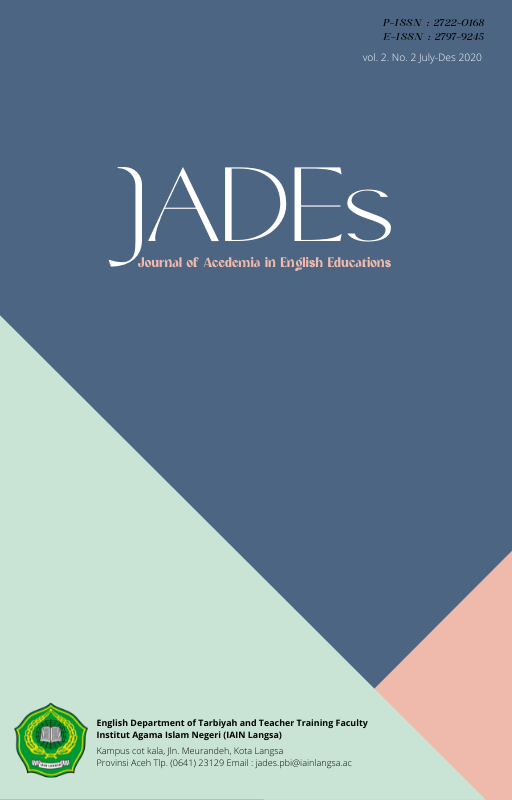Main Article Content
Abstract
This study aims to investigate how high school students view TikTok as a tool for enhancing their self-efficacy in learning English. Over the course of three weeks, 32 grade XI students from a Gresik public school participated in the study, which used a qualitative case study methodology. Semi-structured interviews, classroom observations, and student video analysis were used to gather data. The findings demonstrated that TikTok usage greatly improved students' motivation to use English both within and outside of the classroom, as well as their engagement, speaking confidence, and comprehension of the subject matter through multimodal aspects (text, visual, and audio). Peer support and a collaborative classroom environment effectively maintained students' positive evaluations of TikTok as an effective learning medium, despite obstacles including early shyness and the digital gap. According to this study, TikTok can be a meaningful, entertaining, and contextualized learning tool for the current digital generation.
Keywords
Article Details

This work is licensed under a Creative Commons Attribution 4.0 International License.
References
- Alghameeti, N. (2022). Visual-contextual language input and vocabulary retention among EFL learners. Journal of Language and Learning, 15(2), 101–115.
- Alharthy, A. (2025). The impact of social media on students’ spontaneous English usage outside the classroom. International Journal of Digital Language Learning, 12(1), 34–47.
- Alweldi, H. M., Ahmed, S., & Binti Nor, S. (2024). Self-paced speaking practices and EFL learners’ oral performance using TikTok. International Journal of Educational Technology in Higher Education, 21(1), 88–102.
- Bandura, A. (1997). Self-efficacy: The exercise of control. W.H. Freeman.
- Boon, S., & Wahyuni, R. (2020). Technology barriers in ESL learning in Indonesia. Journal of Educational Technology, 9(4), 123–136.
- Bubb, S., & Jones, M. A. (2020). Learning from the COVID-19 home-schooling experience. Journal of Education, 45(3), 123–139.
- Chen, L., & Kang, Y. (2023). Reducing cognitive load through video-based microlearning: Evidence from second language writing tasks. Language Teaching Research Quarterly, 26(1), 55–68.
- Condoy, M. G. (2024). TikTok as a tool for learner agency and multimodal composition in EFL classrooms. Indonesian Journal of Applied Linguistics, 14(1), 87–99.
- Duan, R. (2023). Reevaluating TikTok: Perceptions of social media in English language learning. ELT Journal, 77(2), 178–190.
- Fata, I. A., Maulida, R., & Ramadhani, A. (2023). The integration of TikTok in EFL learning: Learner engagement and challenges. Asian EFL Journal, 25(4), 135–148.
- Greenhow, C., Lewin, C., & Staudt Willet, K. B. (2021). Social media and education: The dilemma of visibility and its implications for learning and teaching. Learning, Media and Technology, 46(1), 24–40.
- Guzman, R., & Viray, A. (2024). Enhancing ESL learners’ vocabulary through TikTok-based instruction. TESOL International Journal, 19(1), 42–57.
- Hidayah, N. (2024). Self-regulated learning through mobile apps: A case of TikTok in EFL speaking class. Journal of Language Teaching and Research, 15(2), 66–75.
- Hongsa, W., Jumaat, N. A. F., & Shanthi, A. (2023). Vocabulary and text comprehension through TikTok among EFL learners. Journal of Language and Education, 9(1), 34–47.
- Junaidi, M., & Zainuddin, M. (2022). The role of the teacher in implementing TikTok in EFL classrooms. Teaching English with Technology, 22(3), 45–59.
- Khan, M. A., Fatima, Z., & Malik, A. (2022). The potential of TikTok in enhancing English language learning. Language and Education Journal, 10(2), 201–218.
- Lee, L. (2020). Student-generated podcasts for language learning: A case study. International Journal of Computer-Assisted Language Learning and Teaching, 10(4), 55–69.
- Manca, S. (2020). Social media in higher education: Uses, benefits, and challenges. Computers in Human Behavior, 106, 106237.
- Martínez, F., & Jiménez, M. (2021). Short video pedagogy in EFL learning contexts. Educational Media International, 58(3), 225–239.
- Nguyen, T., & Pham, H. (2021). Social media and speaking confidence among Vietnamese EFL learners. Asia TEFL Journal, 18(2), 223–240.
- Rahmah, S., & Yulianto, B. (2023). The effectiveness of TikTok on speaking anxiety in EFL students. Journal of Language Anxiety, 4(1), 88–98.
- Rajan, D., & Ismail, H. (2022). Teacher readiness in implementing TikTok in EFL classrooms. Education and Information Technologies, 27(4), 987–1002.
- Rininggayuh, D. A., Setiawan, A., & Nuraini, R. (2024). Students’ engagement in TikTok-integrated English learning. Journal of Educational Multimedia and Hypermedia, 33(1), 29–44.
- Salazar-Rosas, J. A., Lim, C. S., & Toh, M. K. (2023). TikTok for learning: Student-created content and cognitive processing in ESL contexts. Journal of Language and Technology, 6(2), 88–103.
- Sarkila, S., Rahayu, I., & Widodo, H. P. (2024). Collaborative learning and performance anxiety in TikTok-based speaking tasks. Journal of Language and Social Psychology, 43(1), 73–89.
- Susanto, A., & Suparmi, N. (2024). Contextualized digital materials in English learning: A TikTok-based approach. Journal of English Language Teaching Innovations, 11(1), 122–138.
- Tan, L., Rahim, N., & Yusuf, A. (2023). Social media and learning confidence: A TikTok case study. Journal of Digital Learning, 6(2), 77–89.
- Tandoc, E. C., & Maitra, J. (2018). Algorithmic distraction and implications for education. Journal of Media Literacy Education, 10(1), 45–56.
- Waode, N. (2024). Student motivation and real-time feedback in TikTok language learning environments. Journal of Digital Pedagogies, 7(1), 45–59.
- Wang, L., & Chen, X. (2023). Enhancing EFL learners' oral proficiency through TikTok. Asia-Pacific Journal of Education, 43(2), 134–149.
- Wang, Y., & Liu, Q. (2023). Vicarious learning and student self-efficacy in online environments. Journal of Educational Psychology Research, 21(2), 78–91.
- Zhen, L., Wang, X., & Luo, J. (2022). Reducing speaking anxiety through video-based duet practice on TikTok. Journal of Modern Language Studies, 10(3), 144–158.
- Zidan, B., Rahim, A., & Latifa, N. (2023). Digital habits and learner engagement: TikTok in EFL instruction. International Journal of Emerging Technologies in Learning (iJET), 18(2), 55–69.

